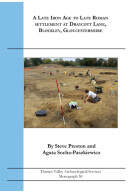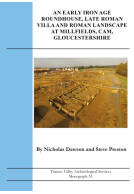Roman Enclosure and Early Anglo-Saxon Occupation at Top Road, Kempsford, Gloucestershire (Paperback)
Imprint: Thames Valley Archaeological Services
Series: TVAS Monograph Series
Pages: 138
ISBN: 9781911228219
Published: 4th September 2017
Script Academic & Professional
Series: TVAS Monograph Series
Pages: 138
ISBN: 9781911228219
Published: 4th September 2017
Script Academic & Professional
Usually available in 6-8 weeks.
You'll be £15.00 closer to your next £10.00 credit when you purchase Roman Enclosure and Early Anglo-Saxon Occupation at Top Road, Kempsford, Gloucestershire. What's this?
+£4.99 UK Delivery or free UK delivery if order is over £40
(click here for international delivery rates)
Order within the next 4 hours, 59 minutes to get your order processed the next working day!
Need a currency converter? Check XE.com for live rates
(click here for international delivery rates)
Order within the next 4 hours, 59 minutes to get your order processed the next working day!
Need a currency converter? Check XE.com for live rates
This volume describes the results of an archaeological excavation carried out in advance of development at Kempsford on the north bank of the River Thames in Gloucestershire. Cropmarks visible in aerial photographs, and a geophysical survey, suggested the site contained Iron Age or Roman enclosures and occupation, and evaluation trenching confirmed that these were indeed present, along with some Anglo-Saxon pottery.
The excavation revealed the expected enclosed settlement, repeatedly remodelled from the Late Iron Age into later Roman times. Burials were also present, mainly from the later Roman period. The later end of the radiocarbon dating ranges could allow two of the burials to be 5th-century Anglo-Saxon rather than late Roman.
Anglo-Saxon occupation with at least six sunken-floored buildings and a post-built hall, was more unexpected. Faunal and botanical remains allowed the agricultural economy of the site to be examined and isotope analysis of the burials indicated a typical terrestrial diet albeit distinctive compared to other Roman sites. A programme of radiocarbon dating on food residues taken from Anglo-Saxon pottery revealed that the settlement was of two phases spanning the early 5th and 6th centuries but with the possibility that occupation had commenced in the late 4th century or very early 5th. This is noteworthy for a site so far up river from the Thames Estuary as it suggests this process may have been underway before the traditional end of the Roman period in AD410.
Other titles in the series...
Other titles in Thames Valley Archaeological Services...











